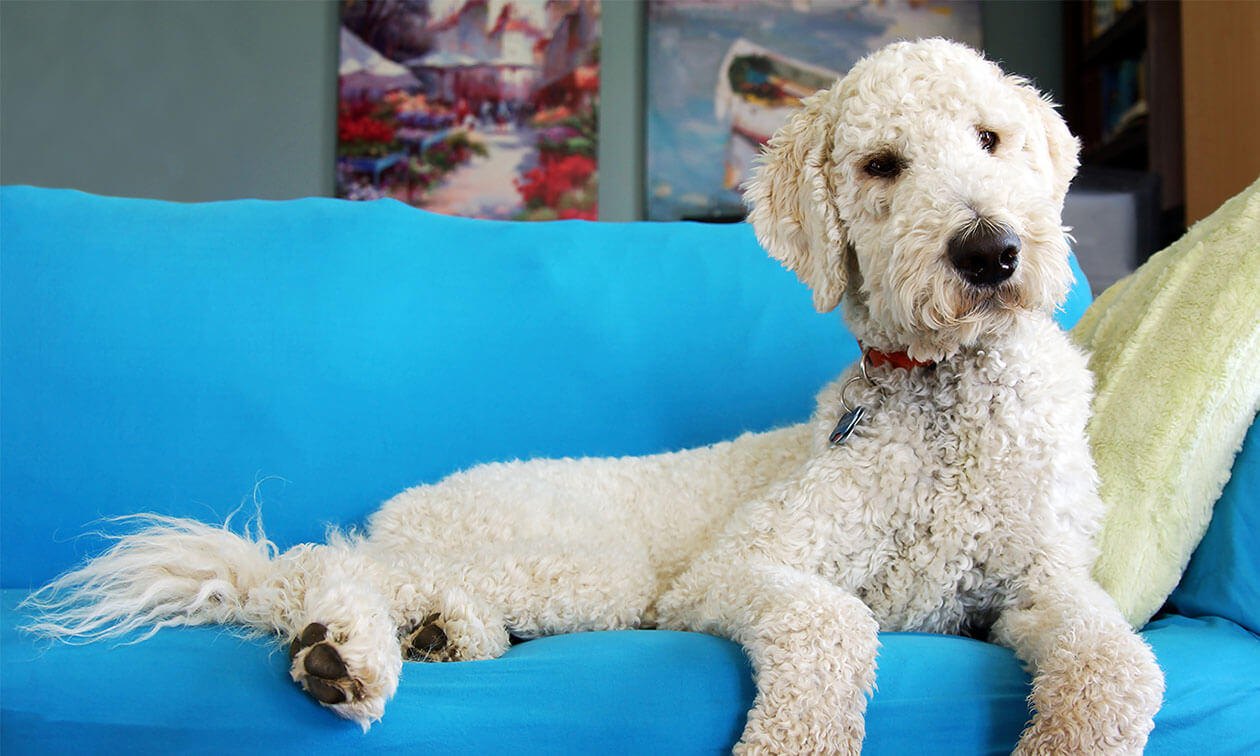Just as there are many amazing facts about dogs, there are also many myths. One common myth is that certain dog breeds don’t shed. It’s just not true. That’s right, even supposedly “hypoallergenic” dogs and “hairless” breeds shed to some extent. At a minimum, they will shed dander. With that said, some dogs do shed less than others. For dogs who shed a bit more, there are ways to help keep the shedding under control.
Why Do Dogs Shed?
Different dogs shed to varying degrees depending on their breed, coat thickness, environmental factors, and health reasons. Dogs will shed more seasonally, often in the spring and fall, as the weather changes.
To Make Space for a New Coat
Dogs have about 15,000 hairs per square inch of skin1, while humans only have about 800 to 1,290 per square inch on their head2. That is a lot of extra hair. They need to shed their coat and even skin to stay healthy. The old, damaged hair needs to go for a new, healthy coat to grow.
Environment
Dogs also shed to adapt to their environment. Two major factors affect when significant shedding occurs: changes in the amount of light per day and changes in external temperatures. For example, dogs in North America shed primarily in the spring and fall when the temperature and daylight hours change.
Health
Shedding can also be affected by hormones, health, nutrition, and genetic factors.
Stress is one of the most common causes of excessive shedding in dogs3. You might notice a lot of fur on your clothing after holding your dog at the veterinarian’s office. Stress causes the skin tissue to expand due to a release of adrenaline, and the hair falls out more easily.
If you suspect your dog is shedding excessively, it’s important to have them evaluated by a veterinarian to rule out medical causes, such as infections, parasites, hormonal imbalances, autoimmune or immune-mediated conditions, and several others.
How To Minimize Your Dog’s Shedding
Even though you can’t stop your dog from shedding, there are some things you can do to reduce or manage it.
Grooming
Routine grooming is essential. Even low-shedding dogs need regular grooming to keep their coat healthy and prevent matting. This includes regular brushing, bathing, and clipping or trimming fur.
When bathing your dog, always use warm to slightly cool water. The skin can become irritated and inflamed if it is too hot, leading to further shedding.
Even though topical products don’t stop or reduce shedding, they make brushing easier and help moisturize your dog’s skin. Use soap-free, moisturizing shampoos and conditioners. Thoroughly rinse their skin and coat completely free of product to prevent residual product from irritating the skin.
Towel drying and letting your dog’s coat air dry naturally will help prevent the skin from becoming dehydrated and decrease irritation, which can help with shedding.
Use a brush that suits your dog’s coat and is designed for daily use. Daily brushing removes loose hair and helps spread your dog’s natural oils through the coat and skin. Brushes designed for de-shedding should be limited to once or twice weekly as they can irritate your dog’s skin if used daily.
Nutrition
Feeding your dog a high-quality, well-balanced diet is optimal for their health and well-being, which includes their coat.
Probiotics may help decrease shedding . By keeping the gut microbiome balanced, dogs are better able to absorb nutrients that help maintain a healthy coat and skin, meaning less shedding4.
Fish oil has anti-inflammatory properties and boosts the immune system. It also can help keep your dog’s coat shiny and healthy. Adding it to your dog’s diet or feeding a diet with added Omega 3 fatty acids can help support a healthy coat and decrease shedding by decreasing itchy, flaky skin, easing allergies, and strengthening the immune system5.
Stress and Anxiety Management
Reducing and managing your dog’s stress and anxiety can help decrease shedding.
Triggers. Identify and try to avoid or manage triggers that cause stress. A certified canine training and behavior consultant can help.
Exercise and environmental enrichment. These can significantly ease a dog’s stress and anxiety.
Microbiome. Studies show that when the gut microbiome is out of balance, it can impact canine anxiety disorders6. Supplementing with certain probiotics may help ease stress, which can lessen shedding.
Calming aids. Calming aids such as pheromone sprays and diffusers or treats may help ease your dog’s anxiety.
Anxiety medication. For more serious cases, consult your veterinarian to determine if prescription medications are necessary to help your dog relax.
Dogs That Shed the Least
If you’re looking for a dog breed that sheds very little, consider the hairless breeds, like the Chinese Crested, Mexican Hairless, and American Hairless Terrier.
You can also look for dogs with a single-layer, continuously growing coat. They require regular grooming because their coat will continue growing in length unless trimmed, but the shedding is minimal. Dogs that shed the least are typically called “hypoallergenic.” They do, however, require frequent brushing.
These breeds may seem like dogs that don’t shed compared to heavy shedding dogs, but they do. Here’s a breakdown by size7:
Low-shedding small dogs include:
- Yorkshire Terrier
- Havanese
- Cairn Terrier
- Bolognese
- Lhasa Apso
- Bichon Frise
- Maltese
- West Highland White Terrier
- Some Poodle mixes
Low-shedding medium dogs include:
- Kerry Blue Terrier
- Tibetan Terrier
- Whippet
- Portuguese Water Dog
- Some Poodle mixes
Low-shedding large dogs include:
- Poodle
- Irish Water Spaniel
- Airedale Terrier
- Giant Schnauzer
- Komondor
- Afghan Hound
Dog Breeds that Shed Most
Just as there are low-shedding breeds, there are dogs that shed a lot. Any dog with a double coat is bound to have a lot of shedding. These can include8:
- Siberian Husky
- Saint Bernard
- Corgi
- Akita
- Chow Chow
- Golden Retriever
- Labrador Retriever
- Alaskan Malamute
- Alaskan Husky
When it comes to managing your dog’s shedding, these heavy-coated dogs will take the most effort and time. Even with daily brushing and regular grooming, you’re bound to find tumbleweeds of fur around your home.
Dogs that don’t shed much still require frequent grooming and care, but if you prefer not to find dog hair all over your home, a low-shedding breed could be the right choice for you.
ZPC-04096
- Not Another Shedding Questions. DVM360. https://www.dvm360.com/view/not-another-shedding-question. Accessed March 25, 2024.
- How Many Hairs Are on the Human Head. Healthline. https://www.healthline.com/health/how-many-hairs-on-a-human-head. Accessed March 25, 2024.
- Signs Your Dog is Stressed and How to Relieve It. VCA Animal Hospitals. https://www.healthline.com/health/how-many-hairs-on-a-human-head. Accessed March 25, 2024.
- Say Goodbye to Excessive Dog Shedding. USA Service Dog Registration. https://usaservicedogregistration.com/stop-excessive-dog-shedding/. Accessed March 25, 2024.
- Fish Oil for Dogs. American Kennel Club. https://www.akc.org/expert-advice/nutrition/fish-oil-for-dogs/. Accessed March 25, 2024.
- Gut-Brain Axis Impact on Canine Anxiety Disorders: New Challenges for Behavioral Veterinary Medicine. National Library of Medicine. https://www.ncbi.nlm.nih.gov/pmc/articles/PMC10827376/. Accessed March 25, 2024.
- 22 Low Shedding Dog Breeds. Purina. https://www.purina.co.uk/find-a-pet/articles/dog-types/fur-type/low-shedding-dog-breeds. Accessed March 25, 2024.
- Dogs That Shed: Why and What You Can Do. Hillspet. https://www.hillspet.com/dog-care/behavior-appearance/why-dogs-shed. Accessed March 25, 2024.



